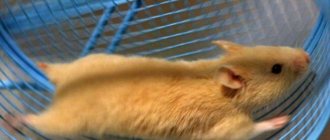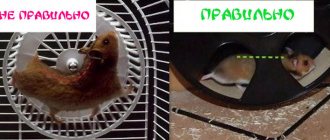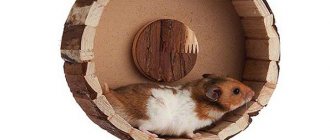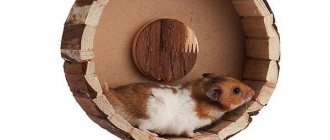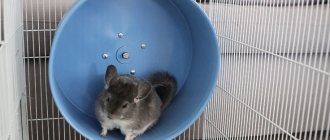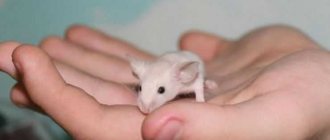Hamsters are known as very active animals, constantly on the move.
This behavior is due to the natural instincts of a rodent, which in the wild constantly has to run and tirelessly get food. Sometimes, while searching for edible grains, roots or tasty grass, hamsters manage to run tens of kilometers. When caring for a pet rodent, it is necessary to remember the origin of the small animals and provide them with a good level of activity to maintain physical fitness and a natural lifestyle. Often rodents living in small cramped cages cannot boast of excellent health, suffering from disruption of various body functions. In this case, a silent hamster wheel will be a salvation, which will allow him to run and be active. If you are interested in learning more about this, read our article why hamsters love to run on wheels. And in this material we will look directly at the wheels themselves.
Why does your hamster need a running wheel?
- The animal trains its muscles, including the heart, keeps itself in healthy shape and at the same time is in its home cage.
- A cage equipped with a wheel brings his home closer to natural conditions, in which he runs for more than ten kilometers.
- You extend the life of your pet.
- Realizing that he was given a new toy with care for him, the hamster will reciprocate your feelings and will be affectionate and playful.
You can buy running wheels at special pet stores. We will tell you what types of running machines there are for hamsters in our article.
Types of running wheels for hamsters
Hamsters of different breeds can be very tiny, from 4.5 cm to large individuals reaching 34 cm in length. Accordingly, some are lighter, others are heavier. Depending on the type of your hamster, you should select a running wheel for your pet.
Which wheel you choose for your hamster’s home will depend not only on its health, but also on its safety. Agree, if you buy a small wheel for a large hamster, and a huge one for a miniature one, then your animals will not be able to run on this simulator.
So the first thing you need to do is decide on the diameter of the running wheel.
For example, for Djungarian hamsters or for a Syrian baby, the diameter of the wheel should be a minimum of 14 cm and a maximum of 16 cm.
An adult Syrian hamster needs wheels more than 18 cm in diameter.
The track in the wheel must be of sufficient width. If its width is not enough, the hamster may fly out of the wheel. For example, for miniature dwarf breeds, a width of 5 cm will be enough, but for Syrian hamsters, the width of the wheel should be at least 7 cm.
The trainer should be the size of your rodent. If you have not chosen the correct diameter of the treadmill, then your baby will squeeze, stumble and get injured in the small wheel. It's hard for kids to run in a wheel that's too big. They have difficulty rotating it and, as a result, will stop using it altogether.
Not only the comfort of your hamster, but also the health of your pet depends on a correctly selected wheel. The consequences of incorrectly purchased running wheels can be sad. Spinal injuries, dislocations of limbs and even fractures are possible.
Running wheels are:
- plastic;
- metal;
- wooden;
- combined.
One of the disadvantages of metal running wheels is that they tend to squeak over time. Considering that your animal loves a nocturnal lifestyle, it will train in its wheel at night. Your sleep and a squeaky wheel don't go well together, would you agree?
The plastic running wheel is quiet and comfortable enough for a hamster to run. The main thing is that the treadmill has small ribs that the little athlete can cling to and not slip off.
Running wheels made from a combination of plastic and metal materials have proven themselves. The wheel itself is made of plastic, and the stand is metal. This is a silent and lightweight design with a reliable metal support.
Important! The treadmill must have traction for the limbs. It doesn't have to be smooth. The hamster will slide and will not be able to push off and, as a result, is likely to fly off the wheel while running.
Basically, lattice, mesh and wooden running toys for hamsters are common. If the wheel has a metal mesh, then the cells should be small so that the furry paws do not fall into them.
Important! The gap between the rotating working part of the surface of the simulator and the fastening of the wheel stand axle must be more than one centimeter. Otherwise, the hamster runs the risk of cutting off its leg, as the limb may get stuck in a narrow space, in which case the “scissors effect” is obtained.
The safest exercise machines are running wheels made of wood. They are also the most expensive.
The only negative is that from time to time the hamster can sharpen its teeth on its treadmill, but this will not cause any harm to its health.
Methods for attaching running wheels
- Hinged - screwed with special fasteners or ordinary wire to the cage lattice. This option is suitable for small cells. During hamster training, there may be sounds of the wheel tapping on the mesh of your pet's home.
- Floor-standing - these wheels stand on a floor stand and fit well into a spacious cage. The main disadvantage is that they are not entirely stable.
- On a stand with floor mounting - this method of mounting is more reliable. The stand attaches securely to the cage floor. This is the safest simulator.
Review of popular models
When choosing a simulator, you can rely on reviews from experienced hamster owners. We will tell you which models are in greatest demand and how much a toy for a furry friend costs. We will consider wheels with a stand and hanging ones separately.
With stand
The horizontal supports of the attraction secure the wheel well for tiny jungle animals. For Syrians, the stand has special hooks with which the toy is fixed to the lower bars of the cage. Here are the most popular models of hamster exercise machines:
- Trixie with a mesh path for dzhungarika. Made of metal, d = 14 cm. The simplest option, but at the same time reliable. Costs about 320 rubles.
- Trixie for Syrian hamsters. A plastic exercise machine, the track is solid, has a ribbed surface. The back wall is closed, the front has 4 slots for entry. This design increases the safety of your pet. D = 24 cm, price from 1000 rubles.
- Darell for Djungarian hamsters. The circle itself is plastic, and the stand is metal. D = 14 cm. Economical option, suitable for the first time, but will quickly break. It costs only 80 rubles.
- Beeztees are a wooden wheel for the Syrian breed. D = 20 cm. The back wall is closed, a stand is attached to it. The attraction is very convenient, and you can also sharpen your teeth on it. Price 1200 rubles.
- Ferplast for dzungarians. Plastic circle with “legs”. The attraction is stable. The diameter of the circle is from 14.5 to 16.5 cm. The average cost is 550 rubles.
- Triol – running plate. Suitable for all breeds of hamsters. The body and surface are plastic, the stand is made in the form of a house for an animal, d = 20 cm. Cost 250 rubles. This is what the plate looks like:
As you can see, circles on a stand are inexpensive, but will take up a lot of space in the cage. If your hamster's apartment is cramped, then it is better to give preference to a suspended trainer.
Hanging
These running circles help save space in your cage. How much do they cost and what brands are the most popular?
- Savic is a universal wheel, suitable for both Syrian and dwarf hamsters. D = 19 cm. This is a cast plastic circle, the track of which has a ribbed surface. Attached to the cage bars with a screw. One of the cheapest hanging options, costs only 370 rubles.
- Ferplast is another universal trainer for all breeds of hamsters. D = 20 cm, ribbed track width 10 cm. Material – plastic. Thanks to the width of the wheel, sports activities will be as safe as possible for your pet. Cost – 420 rubles.
- IPTS is a stylish wheel for a small Djungarian hamster. It is made of plastic, has a mount on the back wall, as well as a removable metal support (that is, it is both suspended and on a stand). A huge advantage of the toy is its noiselessness. D = 16.5 cm. Price – 1300 rubles. There are models from the same company intended for Syrians. The diameter of the circle is 28 cm, and it costs 3,000 rubles.
Thus, plastic running wheels are much more expensive than those made of metal. But they have a huge advantage - they do not knock or squeak. If you don’t want to wake up at night from clanging, then give your preference to them.
When choosing a toy for your pet, pay close attention to the diameter of the circle, the running surface and the strength of the product. A correctly selected wheel will become a fun attraction for your furry, a useful exercise machine, and just a favorite toy!
Buying running wheels - what to consider?
It is good to purchase a trainer together with your pet. This will save, firstly, from mistakes in choosing the wheel size, and secondly, you will see how comfortable your animal is in it. You will appreciate the size of the feet and cells on the treadmills. You need to balance the rodent and the size of the path. You will immediately understand whether your furry pet likes the new toy. And, of course, evaluate his safety on the treadmill - does he fall, does his paws get stuck, does he stumble, and so on.
When choosing an active toy, choose a comfortable and spacious running wheel for your small pet, with a protected surface that prevents injury.
A more durable option, of course, is metal structures with a good running surface.
The pricing policy for treadmills ranges from 100 to 3000 rubles. Please note that cheaper treadmills wear out quickly. There are many good quality running wheels available at reasonable prices.
There are a wide variety of companies that manufacture treadmills for pet rodents. Toys for pets are popular, including running wheels for hamsters, the following, “Ferplast”, “Trixie”, “Beeztees”, “Darell”.
In addition to the fact that there are many types of treadmills for rodents in stores, you can make such a wheel yourself.
Some owners make running wheels for hamsters and connect a generator to it. While running, the hamster spins the exercise machine and generates electricity. Of course, it cannot illuminate your entire home, but an active rodent will be able to charge a mobile phone.
Buy a wheel for your hamster and you will be sure that he will live an energetic and fulfilling life!
How to make a running wheel for a hamster with your own hands?
The hamster wheel is rightfully a favorite exercise machine for both the animal and the owner. It is silent and helps the animal to splash out energy without disturbing a person’s peace. You can buy an inexpensive option in the store. But there is a method of manual production, which is not as difficult as it seems at first glance.
What to consider when purchasing a hamster ball and wheel
The choice of such a toy should be approached carefully and many factors taken into account:
- The hamster wheel must be large enough. For example, for dwarf breeds a product with a diameter of 16 cm is suitable, and for Syrian hamsters this value should be even larger - 18 cm.
- The working surface of the hamster wheel should be mesh or plastic with frequent notches that do not allow the paws to slide.
- Safety. A walking wheel for a hamster should be light, but at the same time durable so that the animal cannot chew or break it.
You can also buy a walking ball for rodents - an original invention that allows the animal to roll around the house and watch what is happening through translucent walls. Just be sure to take special care when closing the lid and remember to remove the animal in a timely manner so as not to overload its cardiovascular system. Plus, the product should have enough holes for air to enter, but they should not be too large, otherwise there is a risk of the foot getting stuck. You can buy a hamster ball in our online store at an affordable price by choosing the appropriate diameter - we have a varied range.
Instructions for making a wheel
Make markings on a plywood sheet
Use a compass to draw a circle. If you don’t have a tool, you can build one with your own hands, for example, from pencils, an eraser and an eraser. The optimal radius of the circle is considered to be 11 cm. This will be the outer side of the wheel, and the 10 cm circle drawn inside the first circle will be the inner one.
The process of cutting out the base and ring
For such purposes, you can use a jigsaw. First you need to cut out a circle with a larger diameter, and from it a smaller circle. In order for the structure to be strong, a circle with a diameter of 12 cm externally and 9 cm internally will be required to strengthen it. After the cutting procedure, the inner circle will not be useful. A number of additional parts can be made from it.
The inner circle part is used to create the rotation mechanism of the wheel. Another function of the part is to attach it to the cage, or more precisely, to the rods. The ideal shape would be a trapezoid with dimensions of 6 cm for the side, 2 cm for the top and 4 cm for the bottom of the figure. At the bottom of the figure, do not forget to make holes to which it will cling with a rope.
The next stage will be working with bamboo wallpaper. The following markings need to be made on the product: length 11 cm, width 66.5 cm. You will need 2 strips with such markings. They must be glued in such a way as to reduce the risk of the animal coming into contact with the adhesive part: this may be unsafe.
Wallpaper can be glued using a non-toxic version of wood glue and a regular brush. Next, you need to let the running structure dry completely.
Hard drive disassembly
In order to remove the necessary parts from the hard drive, it needs to be broken. The disk is necessary to remove the bearing, which will become the main rotation mechanism.
If you have an unnecessary spinner, you can try using a bearing from it.
Then you will need the base for the wheel again. Using a drill, a hole is made in the center of the part, the diameter of which will coincide with the size of the bearing hole.
Then you need to insert the bearing into the prepared hole and work out the place where it will come into contact with the plywood. Use hot glue to secure the parts together.
Attach the ring, 12 cm in diameter, to the base using nails for better fastening. All that remains is to attach the disc part, which has the shape of a crescent, to the trapezoid-shaped element.
Moreover, the fastening should be such that the edges of the month are ultimately attached to the top of the trapezoid. And the tail part of the structure remained outside. Afterwards it needs to be attached to the bearing on the base of the wheel. After attaching the wheel, it is important to check its rotation yourself: it should be easy.
For maximum smoothness of the surfaces of the simulator, you need to treat it with sandpaper. This will help avoid unnecessary injuries and cuts to the animal.
The last stage is attaching the simulator to the cage. This can be done using strong wire. It needs to be threaded through those 2 holes at the bottom of the trapezoid and firmly fixed to the rods.
DIY plastic wheel
There is another option for a homemade exercise machine not made from metal and wooden structures, but using plastic. You will need a plastic CD case and a curved dowel. The degree of inclination should not be less than 90 degrees. Tools that will be useful are a drill, an awl and a jigsaw.
The method of manufacturing a structure consists of the following steps:
- Take the box out of the plastic and measure a distance of 5 cm from the top of it.
- Then you need to draw a straight line around the entire circumference of the box. Using a jigsaw, moving along the intended path, carefully cut it.
- At the next stage, you will need to take a drill with a diameter of 0.6 cm. Using a drill, you need to make a series of holes.
- Then use an awl to push holes across the entire surface of the box. They should not exceed 0.3 cm in diameter. The distance between the holes themselves is no more than 5 mm. Punctures should be located exclusively on the outside of the structure.
- Go over the cut areas with sandpaper to level the surface for the safety of the animal.
- Then insert the dowel into the center of the box and firmly secure the structure to the cage. To do this, you can use wire or hot glue.
Wheel - generator
Other owners with good imagination use other methods of making a simulator for a pet friend. The wheel in the form of a generator is safe for the animal, and looks very original.
Following the instructions, even a beginner can make it:
The optimal starting tool will be the old drive. Thanks to the convenient design, no additional saw is required, which will simplify the task of assembling the structure. Stages of work:
- Remove the casing from the drive, and then the remaining parts. The task is to go into the house to remove the required bearing.
- If the space between the bars of your existing wheel is too wide, a transparent film will help solve the problem. She needs to wrap the surface of the product tightly.
- The bearing can be attached using a regular disc. Ideally it should be transparent. The disk is attached to the wheel using glue.
- Then attach the previously drawn bearing to the disk.
- Attach the device to the cage in any convenient and, most importantly, safe way for the hamster.
Wheels by mounting method
Running wheels for hamsters are divided into three main types, which differ in the way they are attached. For example:
- Fastening to the cage wall using special holders or strong wire (depending on the type of cage). The advantage of such fastenings is the saving of cage space, but the disadvantage is possible knocking on the hamster house while moving;
- The mount at the bottom of the cage is a running wheel on a special stand that holds the exercise machine. The disadvantage of such an installation is poor stability of the structure;
- Attaching an independent device, that is, a wheel on a stand, to the bottom of the cage will be the most successful and safest option, which will eliminate the risk of instability or overturning of the wheel.
|
|
|
|
In addition, there is a good analogue of a traditional exercise machine - a running disc. The design is equipped with a stable stand on which the “plate” is fixed, preventing the rodent from turning over or falling out while running.
In addition to the running wheel, there is another popular accessory for hamsters - a walking ball.
